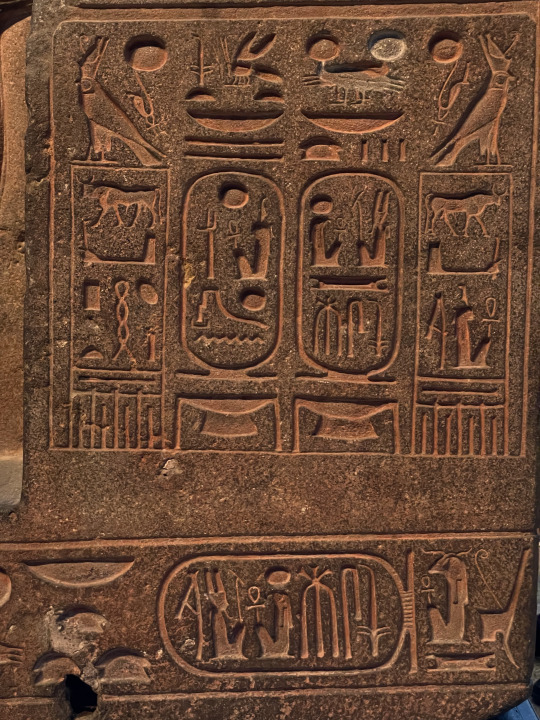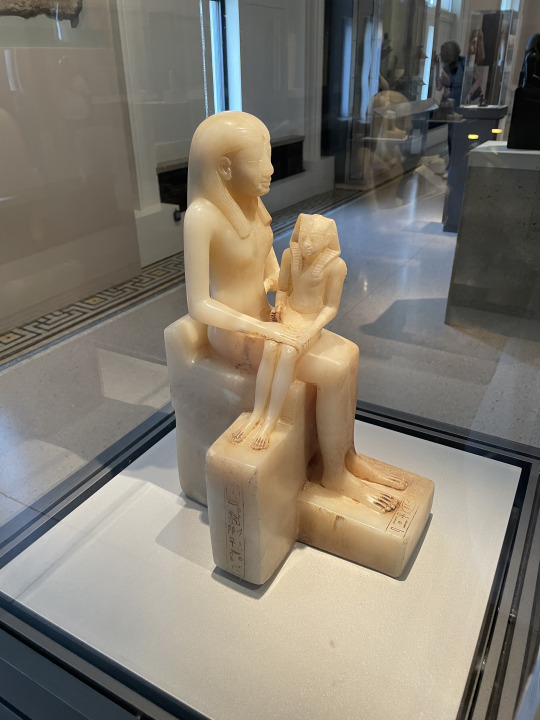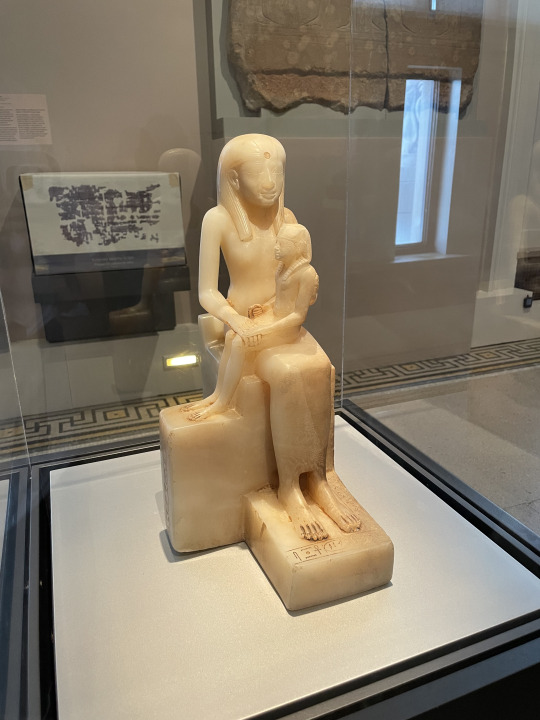Photo


Relief Blocks from the Tomb of the Vizier Nespeqashuty (Late Period; ca. 664-610 B.C.) Brooklyn Museum
How cool is this? You can see the carving process from start to finish. Meticulously planned before carving in red ink, then the initial carving, then a second carving to smooth out the harsh edges left from the original carving.
If you look closely, you can see little phrases written in red ink. According to the museum this “graffiti” is not ancient vandalism, but rather it was done in an act of piety. There are phrases written in Demotic (cursive form of hieroglyphics), Coptic, and Greek.
This is truly one of my favorite pieces in the entire collection at the Brooklyn Museum. I think it speaks for itself, so I don’t want to say too much. It’s so incredible to see the artistic process in action.
(Source)
#my photo#ancient egypt#egyptian art#ancient egyptian art#history blog#art history#art history blog#egypt#brooklyn museum
30 notes
·
View notes
Photo

The Wilbour Plaque (Amarna period, 1352-1336 BC) Brooklyn Museum
The plaque is named for Charles Edwin Wilbour, a 19th century Egyptologist who donated the plaque to the museum.
A masterpiece of “Amarna art” to the modern viewer but was little more than a reference piece in its day. It was most likely carved by a very skilled artist and hung from a cord (note the circular hole in the top) at a workshop to serve as a guide for other artisans working there. The scratches around the faces could have come from the artisans sharpening their tools before carving.
The piece portrays Nefertiti (right) and more than likely Akhenaten (left), her heretic husband who broke dramatically from long established artistic and religious convention. The elongated cranium, the heavy almond-shaped eyes, the full lips, and rounded chin were all very novel to the artistic representation of Akhenaten (p.k.a Amunhotep IV). Akhenaten is one of the most well known Pharaohs in modern times. His other worldly appearance and his worship of the sun certainly make him an interesting case study. Nefertiti is probably most known for her bust, a true masterpiece of sculpture.
Akhenaten is one of my favorite pharaohs. I think he has certainly earned the title of “the world’s first individual”. While I love the devotion to tradition so typical of Egyptian art and religion, its exhilarating to see such a deliberate and stylized break from that tradition. Akhenaten I also enjoy seeing Nefertiti in contexts other than her iconic bust.
(Source) (Source)
#akhenaten#nefertiti#amunhotep iv#ancient egypt#egyptian art#ancient egyptian art#art history#egyptology#egypt#history blog#brooklyn museum#wilbour plaque#art history blog#my photo
37 notes
·
View notes
Photo

Seated statue of Senwosret III (ca. 1836-1818 BC) Brooklyn Museum
Senwosret III (Sometimes called “Senusret” or “Sesostris”) ruled during Egypt’s Middle Kingdom in the 19th century BC. He is credited with sweeping reforms that reestablished the supremacy of the central government. During the first intermediate period the Pharaohs struggled to exercise control over the land, local nobles often wielded more power than the king. Until Senwosret III came along. He divided the land into four provinces, each headed by a vizier. The nobles reported to the viziers and the viziers to Senwosret. The lavish tombs for local nobles, common during the first intermediate period, cease to be built during his reign; a clear indication of the efficacy of his reform.
A seated Pharaoh is a classic trope in Egyptian art. That’s one thing about the Egyptians that I love, their deep affinity for tradition. Kings don’t deviate from long established traditions when it comes to depictions of themselves. One thing worth noting, however, is the expression on Senwosret’s face. His mouth curves slightly downwards and the high cheekbones give the statue a very stern visage. The change in appearance is obvious when viewing statues of other middle kingdom rulers, like Senwosret I.
If I had to guess, the stern facial features are intended to remind the viewer that Senwosret is no pushover. He came to reestablish the legitimacy of the Pharaoh and chew bubble gum, and he’s all out of bubble gum.
(Source) (Source)
#my photo#brooklyn museum#ancient egypt#egyptology#ancient egyptian art#egyptian art#ancient history#history blog#art history#senwosret#senusret#sesostris#senwosret iii#senusret iii#sesostris iii#pharaoh#middle kingdom
99 notes
·
View notes
Photo


Seated Statue of Ramesses II (c.1292-1190 BC) Penn Museum
This statue greets you when you walk in to the Egyptian gallery at the Penn Museum. It’s made of quartzite and is 8 feet tall. It certainly makes an impression on everyone who sees-- which is probably exactly what it was intended to do.
The statue depicts Ramesses II, though it is possible that it was carved during the Middle Kingdom and simply repurposed by Ramesses. Ramesses the Great is one of the most prolific Pharaohs of ancient Egypt. He ruled Egypt for 66 years during the nineteenth dynasty. In that time he negotiated a peace treaty with the Hittites, fathered over 100 children, and commissioned dozens of temples. Future generations of Egyptians would refer to him as the “Great Ancestor”.
The second photo is of the left side of the king’s throne. Notice the top of the third column where there are two suns, one red and one a little more gray. That is an ancient Egyptian typo. The sculptor was supposed to carve a goose with its head facing towards the back of the statue (and a sun disk behind the goose’s head), but accidentally put the sun in the wrong place. The sculptor covered it with plaster and carved the glyph a second time. Museum conservators picked away the plaster during conservation and inadvertently exposed an error covered up for three thousand years. In hindsight I wish I would’ve taken a picture of the right side for comparison, but there is a picture on the Penn Museum’s Website where you can make out the right side of the base. I find it fascinating that hieroglyphics could be written in mirror image, all in the Egyptian’s pursuit of symmetry and aesthetic perfection.
(Source) (Source)
#ramesses ii#ramses ii#ramses the great#ancient egypt#egyptology#my photo#ancient egyptian art#egyptian art#penn museum#university of pennsylvania#history#history blog
50 notes
·
View notes
Photo

Limestone slab of Nefer-safkhy (First intermediate period; c. 2475-2160 BC.) Penn Museum
Nefer-safkhy was a priest of Onuris at This, near Abydos where this slab was found. The piece was featured prominently as part of a behind-the-scenes look at the museum’s archives. It’s a shame its not on display formally, I think it’s a great work of art! It comes from the first intermediate period, dynasties VII-X, a period of time characterized by a collapse in the central government and a rise in power of local governors (nomarchs).
I think this piece wonderfully captures the artistic freedom that artisans enjoyed during the first intermediate period. It is evident that without a central government to dictate artistic style and convention, local artists could “let loose”. Look at the huge eyes and beak-like noses. Even the cows look like they can see into next week. Nefer-safkhy (left), for whose tomb this was commissioned, has two left hands. Sure, it may lack the refinement of the old kingdom, but who says that’s necessarily a bad thing?
Well, I do. Through art, people project their societal values. This piece, to me, indicates a sort of cultural anxiety. The huge eyes are looking to the future, anxious to see what is in store for their fledgling society. The king was god on earth, for him to lose dominion over the land must have been stressful. It may have seemed like the gods had withdrawn their favor.
(Source)
#my photo#ancient egypt#art history#egyptology#ancient egyptian art#egyptian art#history blog#history#first intermediate period#penn museum
54 notes
·
View notes
Photo


Queen Ankhnes-meryre II and her son, King Pepy II (c. 2290-2190 BC) Brooklyn Museum of Art
I recognized this piece immediately. I had seen it a dozen times before in picture books, seeing the real deal was almost like meeting a celebrity. It is made of alabaster.
Ankhnes-meryre served as regent for her son, as his was very young when the previous king died. Size is directly related to importance in Egyptian art. Even though he was young, the artist could have easily made him equal in scale to his mother, justifying it with “well, he is the king”. The fact that Ankhnes-meryre is the size she is indicates she was truly a powerful person.
Pepy II was alleged to have ruled for 96 years. From the age of 4 to the age of 100. As the story goes, he outlived his heirs and not long after his death the Old Kingdom ended and gave way to the First Intermediate period. I’m not sure what the current consensus is on this, but part of me would like to believe that he really did live to be 100, as unlikely as that may be for someone living 4000 years ago.
King Pepy II may have had a homosexual relationship with his general, Sasenet. Fragments of a papyrus tell of the king leaving the palace at night to visit the general and he does “all that he desire[s] with him”. The surviving story is fragmentary and names Pepy II by his throne name “Neferkare”. The ending to the story is lost, so the resolution is unclear. It is possible that the homosexual act is a metaphor or a mythological allusion, i.e. not to be taken literally. (Source)
(Museum website)
#my photo#brooklyn museum#ancient egypt#egyptian history#egyptology#art history#egyptian art#pepy ii#ankhnes-meryre ii#alabaster#history#history blog
6 notes
·
View notes
Photo

Female Figure (3500-3400 BC) Brooklyn Museum of Art
Real women have curves.
First post! Thought it would be fitting for my first post to be of this truly ancient sculpture. It blows my mind that this has survived for over 5000 years. It comes from the Naqada II period, a time in Egypt’s history before the first pharaohs.
She is made of terra cotta, and appears (to me) to be dancing or maybe raising her arms in praise. Maybe she was a priestess? Whoever made this has captured a lot of motion in the piece.
(Museum website)
3 notes
·
View notes